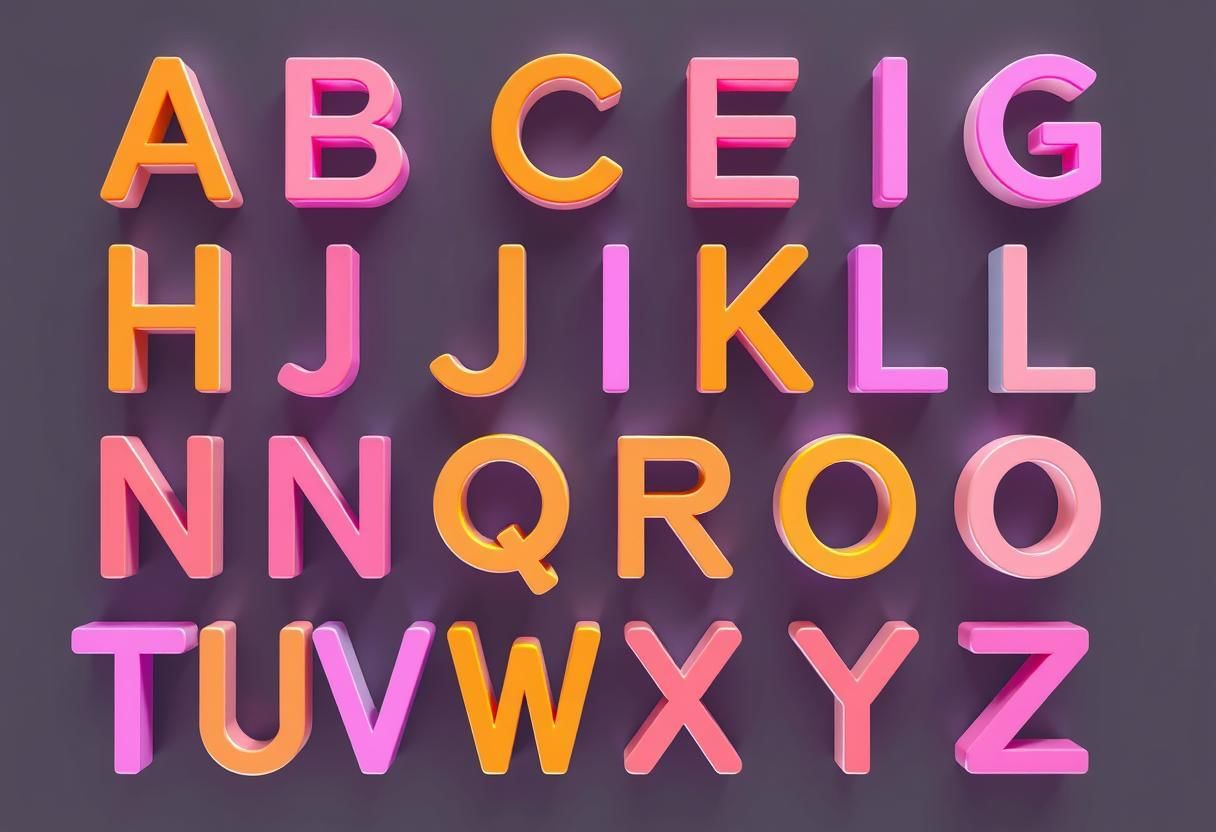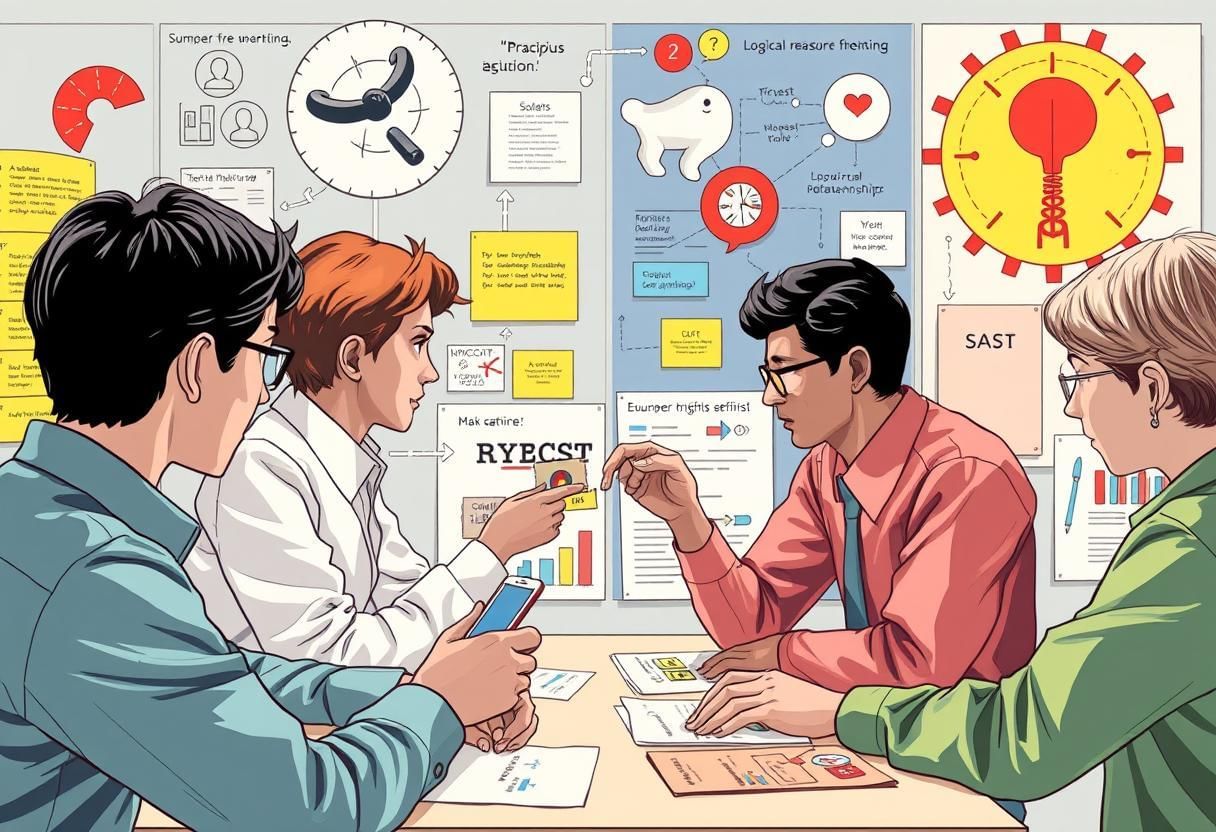Logic Puzzles | Decision Making for UCAT PDF Download
Logic Puzzles in the UCAT Decision Making subtest evaluate your ability to process complex information, apply deductive reasoning, and derive precise conclusions from intricate scenarios. This document offers an in-depth exploration of each topic, advanced strategies, diverse examples, practical exercises, and preparation tips to ensure mastery. Designed for UCAT candidates, this resource aims to build confidence and proficiency in tackling even the most challenging puzzles. Strategic Deduction
Strategic Deduction
1. Understanding and Organizing Information
Logic puzzles often present dense, rule-heavy text that requires careful analysis to extract actionable insights. Mastering this foundational skill involves breaking down information, structuring it visually, and prioritizing relevant details. This process minimizes errors and accelerates problem-solving under the UCAT’s time constraints.
- Text Analysis: Dissect paragraphs into individual rules, noting specific qualifiers (e.g., “immediately next to” vs. “next to”). Misinterpreting terms like “before” or “adjacent” can lead to incorrect deductions.
- Information Structuring: Translate rules into visual formats like tables, grids, or slot-based diagrams. These tools clarify relationships and reduce cognitive overload.
- Identifying Key Facts: Distinguish between critical rules (e.g., fixed positions) and distractors (e.g., vague statements). Focus on clues that directly constrain the solution.
- Notation Skills: Develop a shorthand system (e.g., initials for names, arrows for sequences) to quickly record information on the UCAT whiteboard.
- Rule Prioritization: Start with the most restrictive rules (e.g., “X is in position 1”) to anchor your solution, then apply less restrictive rules (e.g., “X is before Y”).
 Puzzle Mastery
Puzzle Mastery
Example 1: Basic Information Structuring
Question: Four friends (Alice, Bob, Charlie, Dana) sit in a row (positions 1-4). Alice is not next to Bob. Charlie is next to Dana. Bob is in position 1. Who is in position 4?
Solution:
- Extract Rules: Bob in position 1, Charlie next to Dana, Alice not next to Bob.
- Structure: Create a row: [B, _, _, _].
- Apply Rules: Alice cannot be in position 2 (not next to Bob). Charlie and Dana must be adjacent, so they occupy positions 2-3 or 3-4.
- Test Scenarios: Try Charlie-Dana in 3-4: [B, A, C, D] or [B, A, D, C]. Both satisfy all rules (Alice not next to Bob, Charlie next to Dana).
- Conclusion: Position 4 is either Charlie or Dana. Check multiple-choice options for a unique answer.
Answer: Charlie or Dana (context-dependent). Friendship Circle
Friendship Circle
Example 2: Complex Text Analysis
Question: Six books (A, B, C, D, E, F) are on a shelf. Book A is not first or second. Book B is immediately before C. Book D is not next to E. Book F is in position 4. Book C is not last. Which book is in position 6?
Solution:
- Extract Rules: A not in 1 or 2, B immediately before C (B-C), D not next to E, F in 4, C not in 6.
- Structure: Row: [_, _, _, F, _, _]. C not in 6, B-C pair.
- Apply Rules: A in 3, 5, or 6. B-C in 1-2, 2-3, or 5-6 (not 6 for C, so 1-2 or 2-3). D and E not adjacent.
- Test: Try B-C in 1-2: [B, C, _, F, _, _]. A in 3, 5, or 6. Try A in 3: [B, C, A, F, _, _]. D and E in 5-6, but D not next to E. Try B-C in 2-3: [_, B, C, F, _, _]. A in 1, 5, or 6 (not 1 or 2, so 5 or 6). Try A in 5: [D/E, B, C, F, A, E/D]. D not next to E, so [D, B, C, F, A, E].
- Conclusion: Position 6 is E.
Answer: E. Colorful Organization
Colorful Organization
Practice Exercise
Task: Five people (P, Q, R, S, T) in a line. P is not next to Q. R is in position 3. S is before T. List all possible arrangements. (Hint: Use a table to track positions.)
2. Types of Logic Puzzles
Logic puzzles come in distinct formats, each with unique challenges and strategies. Recognizing the puzzle type early allows you to apply the most effective approach, saving time and reducing errors.
- Ranking/Sequencing: Arrange items in a linear order based on relative or absolute positions. Common in puzzles involving time, height, or queues.
- Matching: Assign items to categories or attributes (e.g., people to roles, objects to locations). Requires tracking multiple variables.
- Geographical/Spatial Scenarios: Interpret positional relationships in a layout (e.g., houses in a row, seats in a grid). Visualization is key.
- Mixed Scenarios: Combine elements of sequencing, matching, and spatial reasoning. Break these into sub-puzzles for clarity.
- Constraint-Based Puzzles: Focus on exclusion rules (e.g., “X cannot be next to Y”) to limit possibilities.
 Queue Logic
Queue Logic
Example 1: Sequencing
Question: Six people (E, F, G, H, I, J) stand in a line. E is before F. G is immediately after H. I is not last. J is not first. E is not next to G. Who is third?
Solution:
- Extract Rules: E before F, H-G pair, I not in 6, J not in 1, E not next to G.
- Structure: Row: [_, _, _, _, _, _]. J not in 1, I not in 6. H-G pair in 1-2, 2-3, 3-4, 4-5, or 5-6.
- Apply Rules: Try H-G in 2-3: [_, H, G, _, _, _]. E before F, E not next to G (not in 1 or 4). Try E in 5, F in 6: [_, H, G, _, E, F]. I not in 6, so adjust. Try H-G in 3-4: [_, _, H, G, _, _]. E in 1 or 2, F later. Try E in 1, F in 5: [E, _, H, G, F, _]. I not in 6, J not in 1, so [E, J, H, G, F, I].
- Check: E before F (valid), E not next to G (valid), I not last (valid), J not first (valid). Position 3 is H.
- Conclusion: H is third.
Answer: H. Alphabetical Order
Alphabetical Order
Example 2: Matching
Question: Five dogs (Fido, Rover, Lassie, Max, Spot) are in pens 1-5. Fido is black. Lassie is not in pen 3 or 5. Lassie is next to the black dog. Rover is not in pen 4. Spot is in pen 2. Which dog is in pen 3?
Solution:
- Extract Rules: Fido black, Lassie not in 3 or 5, Lassie next to Fido, Rover not in 4, Spot in 2.
- Structure: Row: [_, S, _, _, _]. Lassie in 1 or 4 (not 3 or 5). Fido next to Lassie. Rover not in 4.
- Apply Rules: Try Lassie in 1, Fido in 2: [L, F, _, _, _]. Spot in 2 (invalid). Try Lassie in 4, Fido in 3 or 5: [_, S, F, L, _]. Rover not in 4, so Max in 5: [_, S, F, L, M]. Position 1 is Rover.
- Check: Lassie next to Fido (valid), Rover not in 4 (valid), Lassie not in 3 or 5 (valid). Position 3 is Fido.
- Conclusion: Fido is in pen 3.
Answer: Fido. Dog Pens Arrangement
Dog Pens Arrangement
Example 3: Spatial Scenario
Question: Six houses (1-6) in a row. House 1 is not brick. House 3 is wooden. House 4 is next to the brick house. House 6 is not stone. Which house is brick?
Solution:
- Extract Rules: House 1 not brick (wooden or stone), house 3 wooden, house 4 next to brick, house 6 not stone (brick or wooden).
- Structure: Row: [_, _, W, _, _, _]. House 4 next to brick (brick in 3 or 5).
- Apply Rules: House 3 is wooden, so brick in 5. Row: [_, _, W, _, B, _]. House 1 not brick (stone or wooden). House 6 not stone (brick or wooden, but 5 is brick, so wooden).
- Test: [S, _, W, _, B, W]. House 2 can be stone or brick. Try brick: [S, B, W, S, B, W]. House 4 next to brick (valid).
- Conclusion: Brick is in house 5 (or 2 and 5, check options).
 Architectural Harmony
Architectural Harmony
Answer: House 5.
Practice Exercise
Task: Four people (A, B, C, D) have jobs (chef, teacher, doctor, lawyer). A is not the chef. B is not the teacher. C is next to the doctor. D is not the lawyer. Create a table to determine who has each job.
3. Deductive Reasoning
Deductive reasoning is the cornerstone of logic puzzles, requiring you to apply rules systematically, eliminate invalid options, and infer new information through logical chains. This skill distinguishes efficient solvers from those who get stuck in complexity.
- Applying Rules: Build solutions by following each rule in sequence, ensuring no violations.
- Elimination Techniques: Rule out options that contradict rules, narrowing the solution space.
- Making Inferences: Combine clues to derive new facts (e.g., if A is before B and B is before C, A is before C).
- Chain Reasoning: Link rules to form a deductive sequence (e.g., A implies B, B implies C, so A implies C).
- Contradiction Analysis: Identify when a scenario leads to an impossible outcome and backtrack.
 Deductive reasoning
Deductive reasoning
Example 1: Basic Deduction
Question: Three houses (1-3) are red, blue, or green. House 1 is not red. House 2 is not blue. The green house is immediately next to the red house. What color is house 3?
Solution:
- Extract Rules: House 1 not red (blue or green), house 2 not blue (red or green), green immediately next to red.
- Structure: House 1: B or G, House 2: R or G, House 3: R, B, or G.
- Apply Rules: Try house 2 red: [_, R, _]. Green in 1 or 3. Try house 1 green: [G, R, B]. Green next to red (valid). Try house 3 green, house 2 red: [B, R, G]. Green next to red (valid).
- Infer: House 3 is blue in the first case, green in the second. Check options for consistency.
- Conclusion: House 3 is blue (assuming unique answer).
Answer: Blue. Colorful Community
Colorful Community
Example 2: Complex Deduction
Question: Five people (J, K, L, M, N) have jobs (chef, teacher, doctor, lawyer, engineer). J is not the chef or teacher. The doctor is immediately next to the chef. M is not the doctor or lawyer. K is not the engineer. Who is the teacher?
Solution:
- Extract Rules: J not chef or teacher, doctor next to chef, M not doctor or lawyer, K not engineer.
- Structure: Table: Rows (J, K, L, M, N), Columns (chef, teacher, doctor, lawyer, engineer). Mark exclusions: J not C/T, M not D/L, K not E.
- Apply Rules: J is doctor, lawyer, or engineer. M is chef, teacher, or engineer. Doctor-chef pair (e.g., 1-2, 2-3).
- Infer: Try L as chef, doctor next to chef. M not doctor, so J or K doctor. Test: L chef, J doctor, K teacher, M engineer, N lawyer. Check: J not chef/teacher (valid), M not doctor/lawyer (valid), K not engineer (valid).
- Conclusion: K is the teacher.
Answer: K. Visual Logic
Visual Logic
Practice Exercise
Task: Four items (W, X, Y, Z) in a row. W is before X. Y is not next to Z. Z is not first. Deduce the possible positions for Y. (Hint: Use chain reasoning to link rules.)
Visual aids are indispensable for organizing complex puzzle information, especially under time pressure. Mastering these techniques allows you to externalize reasoning and avoid mental overload.
- Tables/Grids: Use tables to track assignments (e.g., people to jobs) or exclusions (e.g., who cannot be in a position).
- Diagrams: Sketch spatial layouts (e.g., a row of houses, a seating chart) to visualize relationships.
- Abbreviations: Develop shorthand (e.g., C for Charlie, B for brick) to note information quickly.
- Slot-Based Notation: Represent positions as numbered slots and fill them as rules are applied.
- Color Coding: Mentally or physically (on practice paper) differentiate categories (e.g., people vs. attributes) to clarify relationships.
4. Visual Representation Techniques
Visual aids are indispensable for organizing complex puzzle information, especially under time pressure. Mastering these techniques allows you to externalize reasoning and avoid mental overload.
- Tables/Grids: Use tables to track assignments (e.g., people to jobs) or exclusions (e.g., who cannot be in a position).
- Diagrams: Sketch spatial layouts (e.g., a row of houses, a seating chart) to visualize relationships.
- Abbreviations: Develop shorthand (e.g., C for Charlie, B for brick) to note information quickly.
- Slot-Based Notation: Represent positions as numbered slots and fill them as rules are applied.
- Color Coding: Mentally or physically (on practice paper) differentiate categories (e.g., people vs. attributes) to clarify relationships.
Example 1: Table for Matching
Question: Four people (J, K, L, M) have pets (cat, dog, bird, fish). J does not have the cat. K is not the dog owner. L is not the fish owner. The bird owner is next to the cat owner. Who has the dog?
Solution:
- Extract Rules: J not cat, K not dog, L not fish, bird next to cat.
- Structure: Table: Rows (J, K, L, M), Columns (cat, dog, bird, fish). Mark exclusions: J not cat, K not dog, L not fish.
- Apply Rules: M must be dog (K not dog, others assigned). Try L as cat, bird next to cat. J as bird, K as fish: J-bird, L-cat, M-dog, K-fish.
- Check: Bird next to cat (valid), exclusions valid.
- Conclusion: M has the dog.
Answer: M.
Example 2: Diagram for Spatial
Question: Six seats (1-6) in a row. Seat 3 is taken by P. Q is not next to P. R is in seat 1. S is not last. T is before U. Who is in seat 6?
Solution:
- Extract Rules: P in 3, Q not next to P, R in 1, S not in 6, T before U.
- Structure: Diagram: [R, _, P, _, _, _]. Q not in 2 or 4. S not in 6.
- Apply Rules: T before U. Try Q in 6, but S not in 6. Try U in 6, T in 2 or 5: [R, T, P, _, _, U]. Q in 5, S in 4: [R, T, P, S, Q, U].
- Check: Q not next to P (valid), S not last (valid), T before U (valid).
- Conclusion: Seat 6 is U.
Answer: U.
Practice Exercise
Task: Five houses (1-5) with colors (red, blue, green, yellow, white). House 1 is not red. House 3 is blue. House 4 is next to yellow. Create a diagram to determine the color of house 5.
5. Time Management and Efficiency
With approximately 1 minute per question, efficient strategies are critical to balance speed and accuracy. These techniques help you prioritize effort and avoid getting bogged down in complex puzzles.
- Selective Focus: Target clues that directly address the question, ignoring extraneous details.
- Tunnel Vision Strategy: Focus on answer options or frequently mentioned elements to streamline deductions.
- Guessing and Testing: Make educated guesses based on partial information, then verify for contradictions.
- Skipping Complex Steps: If a puzzle seems overly time-consuming, select a likely answer and move on, returning if time permits.
- Pattern Recognition: Identify common puzzle structures to apply familiar strategies quickly.
 Efficiency Boost
Efficiency Boost
Example 1: Selective Focus
Question: Five chairs (1-5) have colors (red, blue, green, yellow, white). Chair 1 is not yellow. Chair 2 is blue. Chair 3 is next to red. Chair 5 is not green. What color is chair 4?
Solution:
- Extract Rules: Chair 1 not yellow, chair 2 blue, chair 3 next to red, chair 5 not green.
- Focus on Chair 4: Row: [_, B, _, _, _]. Chair 3 next to red (red in 2 or 4, but 2 is blue, so red in 4).
- Conclusion: Chair 4 is red.
Answer: Red. Colorful Seating Arrangement
Colorful Seating Arrangement
Example 2: Tunnel Vision
Question: Six people (A, B, C, D, E, F) in a line. A is not first. B is before C. D is not next to E. F is in position 3. B is not last. Who is in position 1?
Solution:
- Extract Rules: A not 1, B before C, D not next to E, F in 3, B not 6.
- Focus on Position 1: Row: [_, _, F, _, _, _]. A not 1, B not 6. Position 1: B, C, D, or E.
- Test: Try B in 1, C later: [B, _, F, _, _, _]. D not next to E. Valid so far.
- Conclusion: Position 1 is B (check options).
Answer: B.
Practice Exercise
Task: Five items (P, Q, R, S, T) in a row. P is not next to Q. R is before S. T is in position 2. Use the tunnel vision strategy to determine who is in position 5 in under 30 seconds.
6. Common Puzzle Formats
Understanding typical puzzle formats allows you to anticipate structures and apply tailored strategies. Each format has distinct characteristics that guide your approach.
- Linear Arrangements: Items in a single sequence (e.g., people in a queue). Focus on relative and absolute positions.
- Group Assignments: Assign items to categories (e.g., people to teams, objects to attributes). Use tables to track assignments.
- Conditional Logic: Handle “if-then” statements or conditional rules. Test scenarios based on conditions.
- Relative Positioning: Interpret clues about relative placement (e.g., “next to,” “before”). Visualize relationships.
- Exclusion-Based Puzzles: Focus on rules that limit possibilities (e.g., “X cannot be Y”).
 Logical Grouping
Logical Grouping
Example 1: Linear Arrangement
Question: Five people (P, Q, R, S, T) in a row (1-5). P is not next to Q. R is in position 3. S is not last. T is before P. Who is in position 5?
Solution:
- Extract Rules: P not next to Q, R in 3, S not in 5, T before P.
- Structure: Row: [_, _, R, _, _]. S not in 5, so P or Q in 5.
- Apply Rules: T before P. Try P in 5, T in 1 or 2: [T, _, R, _, P]. Q not next to P, so Q not in 4. Try Q in 2, S in 4: [T, Q, R, S, P].
- Check: P not next to Q (valid), S not last (valid), T before P (valid).
- Conclusion: Position 5 is P.
Answer: P.
Example 2: Conditional Logic
Question: Six seats (1-6). If A is in 1, B is not in 2. If B is in 3, C is in 4. If C is in 6, D is in 5. A is in 1. Where is D?
Solution:
- Extract Rules: A in 1, then B not in 2. B in 3, then C in 4. C in 6, then D in 5. A in 1.
- Structure: Row: [A, _, _, _, _, _]. B not in 2.
- Apply Rules: Try B in 3, C in 4: [A, _, B, C, _, _]. C not in 6, so D not in 5. Try C in 6, D in 5: [A, _, _, _, D, C]. B not in 2, so valid.
- Conclusion: D is in 5 if C is in 6, otherwise not fixed. Assume condition applies.
- Conclusion: D is in position 5.
Answer: Position 5.
Practice Exercise
Task: Five people (A, B, C, D, E) in teams (X, Y). A and B are not in the same team. C is in team X. D is not in team Y. Determine the team assignments.
7. Handling Complexity
Complex puzzles with multiple rules or incomplete information require advanced strategies to simplify and solve efficiently. These techniques help you navigate ambiguity and avoid getting overwhelmed.
- Dealing with Incomplete Information: Deduce as much as possible with partial data, recognizing when multiple solutions are valid.
- Avoiding Overcomplication: Focus on the simplest path to the answer, avoiding unnecessary deductions.
- Managing Contradictions: Identify rule violations and backtrack to explore alternative scenarios.
- Breaking Down Complexity: Divide puzzles into smaller sub-problems (e.g., solve for one position first).
- Iterative Testing: Test hypotheses systematically, refining based on new information.
 Strategic Complexity
Strategic Complexity
Example 1: Incomplete Information
Question: Six people (M, N, O, P, Q, R) sit in a row. M is not next to N. O is in position 3. P is not first. Q is before R. Who is in position 6?
Solution:
- Extract Rules: M not next to N, O in 3, P not in 1, Q before R.
- Structure: Row: [_, _, O, _, _, _]. P not in 1, M not next to N, Q before R.
- Apply Rules: Position 6: M, N, Q, or R (P not 1, O in 3). Q before R, so R in 6, Q earlier. Try: [_, _, O, _, Q, R]. M not next to N.
- Conclusion: R is likely in 6, but multiple configurations possible. Check options.
Answer: R (assuming unique answer).
Example 2: Managing Contradictions
Question: Five books (W, X, Y, Z, V) on a shelf. W is not next to X. Y is in position 2. Z is not last. V is before W. Which book is in position 5?
Solution:
- Extract Rules: W not next to X, Y in 2, Z not in 5, V before W.
- Structure: Row: [_, Y, _, _, _]. Z not in 5, so W or X in 5. V before W.
- Apply Rules: Try W in 5, V earlier: [V, Y, _, _, W]. X not next to W, so X not in 4. Try X in 3: [V, Y, X, Z, W]. Valid. Try X in 5: [V, Y, _, W, X]. W next to X (invalid).
- Conclusion: Position 5 is W.
Answer: W.
Practice Exercise
Task: Six items (A, B, C, D, E, F) in a row. A is not next to B. C is in position 4. D is before E. F is not first or last. Identify all possible positions for A.
Preparation Tips
Mastering logic puzzles requires a structured approach to practice and skill development. These detailed tips will help you optimize your preparation for the UCAT Decision Making subtest. Puzzle Time
Puzzle Time
- Use Official UCAT Materials: Access practice tests from the UCAT Consortium to familiarize yourself with authentic question formats and difficulty levels.
- Simulate Exam Conditions: Practice under timed conditions (1 minute per question) to build speed and composure under pressure.
- Target Weaknesses: Identify specific puzzle types (e.g., conditional logic, spatial scenarios) where you struggle and dedicate focused practice to improve.
- Review Mistakes Thoroughly: Analyze incorrect answers to pinpoint logical errors, misinterpretations, or time management issues. Keep a log of common mistakes.
- Master Visual Tools: Practice drawing tables, grids, and diagrams rapidly to internalize these techniques. Aim to create a visual aid in 10-15 seconds.
- Leverage External Resources: Use platforms like MedEntry, UCAT Masterclass, or BlackStone Tutors for additional practice questions, video tutorials, and strategy guides.
- Develop a Practice Schedule: Dedicate 30-45 minutes daily to logic puzzles, gradually increasing complexity. Include a mix of puzzle types to build versatility.
- Practice Mental Agility: Solve puzzles mentally before writing to enhance quick thinking, then verify with diagrams to ensure accuracy.
|
16 videos|21 docs|27 tests
|
FAQs on Logic Puzzles - Decision Making for UCAT
| 1. What are logic puzzles and why are they important for the UCAT exam? |  |
| 2. How can I improve my deductive reasoning skills for solving logic puzzles? |  |
| 3. What types of logic puzzles should I expect on the UCAT exam? |  |
| 4. What are effective time management strategies for solving logic puzzles during the UCAT? |  |
| 5. How can visual representation techniques help in solving complex logic puzzles? |  |
















